*Climate Data has been recorded at Barkley Regional Airport in West Paducah since 1949 and prior to that was observed in downtown Paducah back to December of 1937.
In 1983, legislation was signed creating a federal holiday marking the birthday of Rev. Dr. Martin Luther King, Jr. The holiday was first observed in 1986. King's Birthday is technically on January 15th but the federal holiday is celebrated on the third Monday of January. For climate purposes, the third Monday in January for the entire period of record will be used. This means the holiday can occur from January 15th through January 21st for any given year.
Here is a look at high and low temperature frequencies and extremes as well as precipitation statistics for MLK Jr. Day in Paducah.
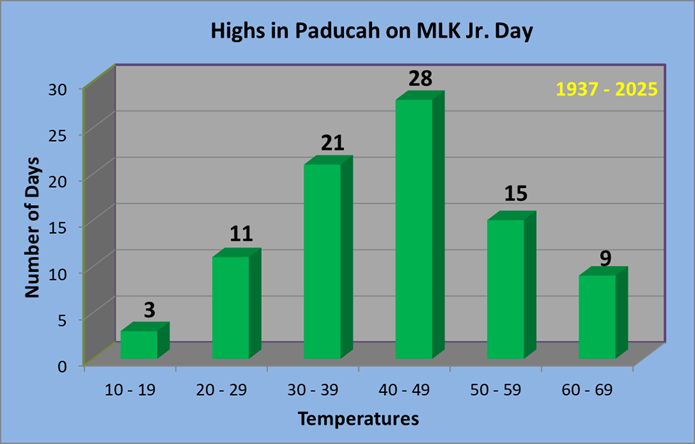
As seen by this graphic high temperatures are predominately in the 30s or 40s on MLK Jr Day, encompassing 61% of all years on record.
| Warmest Highs | Coldest Highs |
| 65 in 1990 | 12 in 2024 |
| 64 in 2017 | 14 in 1977 |
| 63 in 2012 | 18 in 1985 |
| 62 in 1938 | 21 in 1970 |
| 61 in 2015 | 22 in 2025 |
| 61 in 2007 | 22 in 2016 |
| Normal High: | 43 |
Paducah has seen highs as warm as the 60s 9 times, most recently in 2023, when we topped out at 60 degrees. There have also been 3 years where the high temperature failed to reach 20 degrees. This occurred back in 2024, 1985, and 1977.
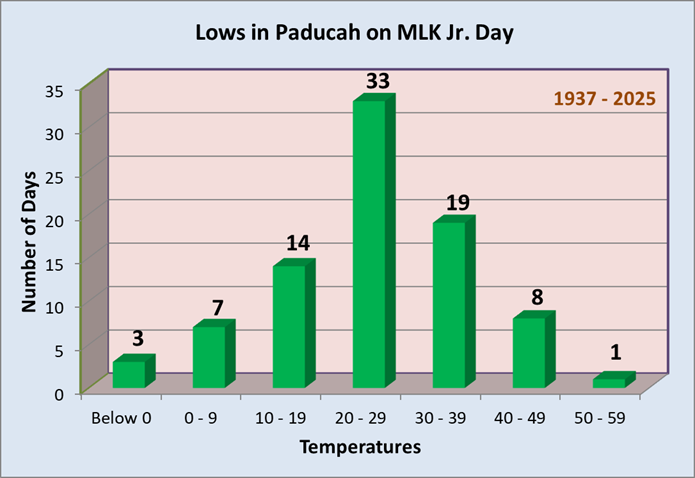
Low temperatures typically fall in the 20s or 30s, accounting for 65% of all years on record. There are always exceptions to the norm of course: in 1977 the low temperature plummeted to 11 degrees below zero, which is 1 of 3 years with lows below zero. The only year with lows above 50 occurred back in 1990 when a mild reading of 52 degrees was set.
| Warmest Lows | Coldest Lows |
| 52 in 1990 | -11 in 1977 |
| 49 in 2023 | -10 in 1985 |
| 48 in 1957 | -3 in 1994 |
| 45 in 2012 | 2 in 1979 |
| 44 in 1938 | 4 in 2024 |
| Normal Low: | 26 |
Measurable precipitation has fallen 33% of the time, with over an inch of precipitation falling on 2 different occasions, most recently in 2007. Measurable snowfall has only occurred on 7 occasions (8% of all years on record), with the most recent occurring in 2024. There have been 12 years (15% of all years on record) with a snow depth of 1 inch or greater. This last happened on MLK Jr Day in 2024 when there was a snow depth of 1 inch in the morning.
| Wettest (inches) | Snowiest (inches) | Most Snow Depth |
| 1.89 in 1958 | 11.0 in 1978 | 8.0 in 1968 |
| 1.06 in 2007 | 8.1 in 2018 | 7.0 in 1994 |
| 0.91 in 1949 | 5.4 in 1994 | 6.0 in 1978 |
| 0.90 in 1978 | 0.4 in 1987 | 4.0 in 1985 |
| 0.68 in 1946 | 0.3 in 2024* | 3.0 in 1982 |
*Denotes a tie in previous year(s)
Here is a look at the observed weather for the past 15 years:
| Recent MLK Jr. Day Weather | |||||
| Year | High | Low | Precip | Snowfall | Snow Depth |
| 2011 | 46 | 22 | 0.16 | 0 | 0 |
| 2012 | 63 | 45 | T | 0 | 0 |
| 2013 | 35 | 23 | 0 | 0 | 0 |
| 2014 | 57 | 32 | 0 | 0 | 0 |
| 2015 | 61 | 27 | 0 | 0 | 0 |
| 2016 | 22 | 9 | 0 | 0 | 0 |
| 2017 | 64 | 43 | 0.54 | 0 | 0 |
| 2018 | 31 | 14 | 0.33 | 8.1 | 2 |
| 2019 | 28 | 19 | T | T | 1 |
| 2020 | 26 | 18 | T | T | 0 |
| 2021 | 50 | 28 | T | T | 0 |
| 2022 | 46 | 26 | 0.01 | 0.1 | 0 |
| 2023 | 60 | 49 | 0.2 | 0 | 0 |
| 2024 | 12 | 4 | 0.02 | 0.3 | 1 |
| 2025 | 22 | 8 | 0 | 0 | 0 |
*Climate Data has been recorded at Evansville Regional Airport since January of 1897. Snowfall records began in January of 1948.
In 1983, legislation was signed creating a federal holiday marking the birthday of Rev. Dr. Martin Luther King, Jr. The holiday was first observed in 1986. King's Birthday is technically on January 15th but the federal holiday is celebrated on the third Monday of January. For climate purposes, the third Monday in January for the entire period of record will be used. This means the holiday can occur from January 15th through January 21st for any given year.
Here is a look at high and low temperature frequencies and extremes as well as precipitation statistics for MLK Jr. Day in Evansville.
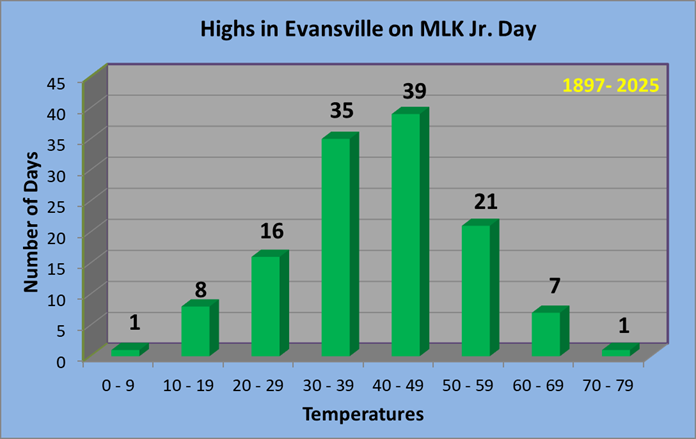
As seen by this graphic high temperatures are predominately in the 30s or 40s on MLK Jr Day, encompassing 60% of all years on record.
| Warmest Highs | Coldest Highs |
| 71 in 1928 | 8 in 1977 |
| 63 in 1990 | 14 in 2024 |
| 63 in 1957 | 15 in 1985 |
| 63 in 1906 | 17 in 1924 |
| 62 in 1919 | 18 in 2025* |
| Normal High: | 41 |
*Denotes a tie in previous year(s)
Evansville has seen highs of 60 or above 8 times, most recently in 2012, when we topped out at 61 degrees. There have also been 9 years where the high temperature failed to reach 20 degrees. This happened most recently back in 2025 when the high was a frigid 18 degrees!
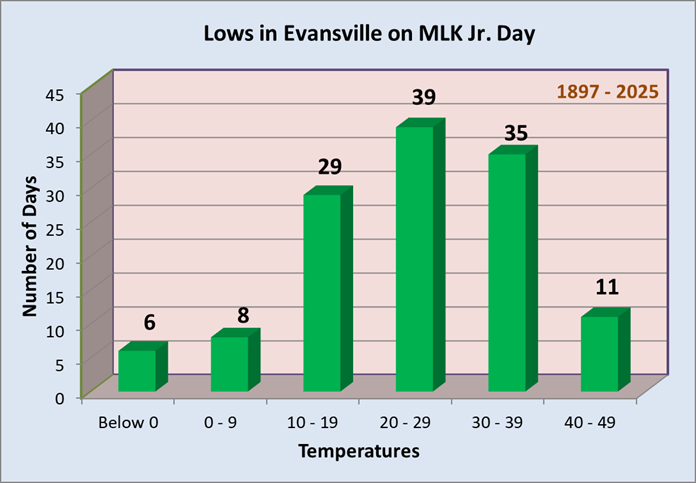
Low temperatures typically fall in the 20s or 30s, accounting for 60% of all years on record. There are always exceptions to the norm of course: in 1977 the low temperature plummeted to 21 degrees below zero, which is 1 of 6 years with lows below zero. The warmest low temperature occurred back in 1928 with a reading of 49 degrees.
| Warmest Lows | Coldest Lows |
| 49 in 1928 | -21 in 1977 |
| 45 in 1990 | -7 in 1979 |
| 45 in 1974 | -4 in 1985 |
| 44 in 1933 | -4 in 1912 |
| 44 in 1914* | -2 in 1963 |
| Normal Low: | 24 |
*Denotes a tie in previous year(s)
Measurable precipitation has fallen 36% of the time, with over an inch of precipitation falling only once, back in 1958. Measurable snowfall has only occurred on 11 occasions (15% of all years on record), with the most recent occurring in 2022. There have been 10 years (14% of all years on record) with a snow depth of 1 inch or greater. This last happened on MLK Jr Day in 2018 when there was 1 inch of snow on the ground.
| Wettest (inches) | Snowiest (inches) | Most Snow Depth |
| 1.09 in 1958 | 7.8 in 1978 | 8.0 in 1968 |
| 0.99 in 2007 | 2.8 in 2018 | 6.0 in 1994 |
| 0.81 in 1915 | 2.7 in 1994 | 6.0 in 1977 |
| 0.66 in 1913 | 1.0 in 2009 | 4.0 in 1978 |
| 0.63 in 1978 | 0.5 in 1976* | 2.0 in 1982* |
*Denotes a tie in previous year(s)
Here is a look at the observed weather for the past 15 years:
| Recent MLK Jr. Day Weather | |||||
| Year | High | Low | Precip | Snowfall | Snow Depth |
| 2011 | 43 | 21 | 0.05 | 0 | 0 |
| 2012 | 61 | 35 | 0.03 | 0 | 0 |
| 2013 | 29 | 17 | 0 | 0 | 0 |
| 2014 | 52 | 31 | T | 0 | 0 |
| 2015 | 57 | 27 | 0 | 0 | 0 |
| 2016 | 22 | 10 | T | T | 0 |
| 2017 | 59 | 41 | 0.32 | 0 | 0 |
| 2018 | 29 | 11 | 0.14 | 2.8 | 1 |
| 2019 | 24 | 11 | 0 | 0 | T |
| 2020 | 23 | 16 | T | T | 0 |
| 2021 | 47 | 28 | 0 | 0 | 0 |
| 2022 | 31 | 19 | 0.05 | 0.3 | 0 |
| 2023 | 54 | 39 | 0.17 | 0 | 0 |
| 2024 | 14 | 4 | 0 | 0 | T |
| 2025 | 18 | 5 | 0 | 0 | 0 |
*Climate Data has been recorded at Cape Girardeau Regional Airport, located 5 miles southwest of Cape Girardeau, since June of 1960.
In 1983, legislation was signed creating a federal holiday marking the birthday of Rev. Dr. Martin Luther King, Jr. The holiday was first observed in 1986. King's Birthday is technically on January 15th but the federal holiday is celebrated on the third Monday of January. For climate purposes, the third Monday in January for the entire period of record will be used. This means the holiday can occur from January 15th through January 21st for any given year.
Here is a look at high and low temperature frequencies and extremes as well as precipitation statistics for MLK Jr. Day in Cape Girardeau.
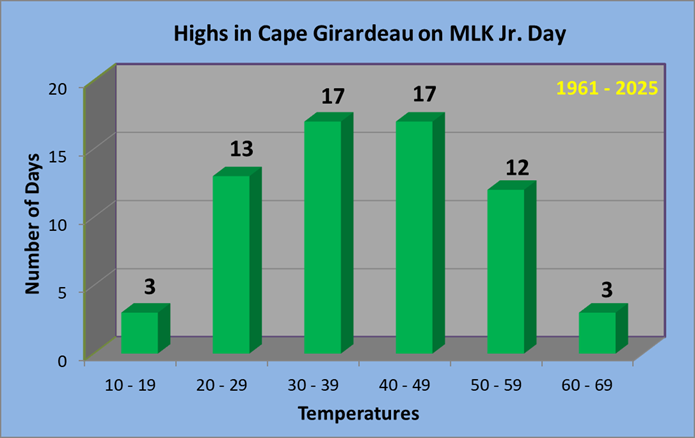
As seen by this graphic high temperatures are predominately in the 30s or 40s on MLK Jr Day, encompassing 54% of all years on record.
| Warmest Highs | Coldest Highs |
| 66 in 1990 | 12 in 2024 |
| 63 in 2012 | 12 in 1977 |
| 62 in 2017 | 19 in 1985 |
| 59 in 2023 | 20 in 2025 |
| 58 in 2015 | 20 in 1970 |
| 58 in 1964 | 22 in 2016 |
| Normal High: | 42 |
Cape Girardeau has seen highs in the 60s three times, most recently in 2017, when we topped out at 62 degrees. There have also been 3 years where the high temperature failed to reach 20 degrees. This happened most recently back in 2024 when the high was a frigid 12 degrees!
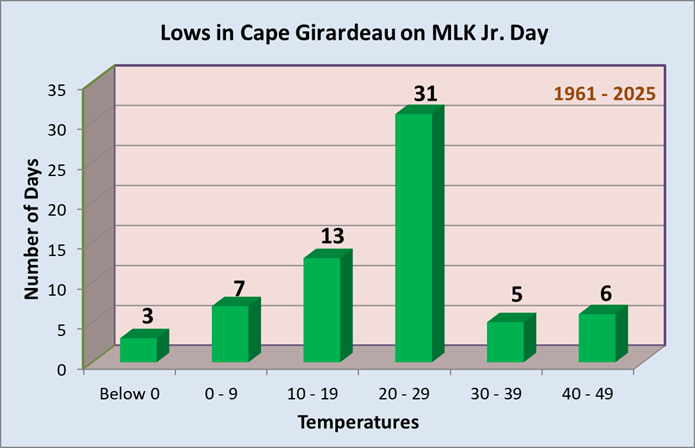
Low temperatures typically fall in the 20s, accounting for 49% of all years on record. There are always exceptions to the norm of course: in 1977 the low temperature plummeted to 16 degrees below zero, which is 1 of 3 years with lows below zero. There have been 6 years with lows in the 40s, the most recent in 2023 with a reading of 48 degrees.
| Warmest Lows | Coldest Lows |
| 48 in 2023 | -16 in 1977 |
| 48 in 1990 | -5 in 1985 |
| 43 in 1974 | -2 in 1979 |
| 41 in 2012 | 1 in 1994 |
| 40 in 2017* | 2 in 1963 |
| Normal Low: | 24 |
*Denotes a tie in previous year(s)
Measurable precipitation has fallen 30% of the time, with over an inch of precipitation falling only once, back in 1978.
| Wettest |
| 1.10 in 1978 |
| 0.69 in 2007 |
| 0.38 in 1976 |
| 0.24 in 1994 |
| 0.19 in 2006 |
Here is a look at the observed weather for the past 15 years:
| Recent MLK Jr. Day Weather | |||
| Year | High | Low | Precip |
| 2011 | 46 | 22 | 0.06 |
| 2012 | 63 | 41 | 0.02 |
| 2013 | 37 | 22 | 0 |
| 2014 | 55 | 25 | 0 |
| 2015 | 58 | 27 | 0 |
| 2016 | 22 | 7 | 0 |
| 2017 | 62 | 40 | 0.12 |
| 2018 | 30 | 14 | 0.07 |
| 2019 | 28 | 20 | 0 |
| 2020 | 27 | 18 | T |
| 2021 | 49 | 26 | M |
| 2022 | 46 | 27 | 0 |
| 2023 | 59 | 48 | 0.03 |
| 2024 | 12 | 3 | 0 |
| 2025 | 20 | 7 | 0 |
Climate Data has been recorded at the Poplar Bluff Airport, located 4 miles east of Poplar Bluff, since December of 1997. Prior to that data was taken at the Poplar Bluff COOP station, located a half mile west of downtown. Data for the COOP station dates back to January 1893.
In 1983, legislation was signed creating a federal holiday marking the birthday of Rev. Dr. Martin Luther King, Jr. The holiday was first observed in 1986. King's Birthday is technically on January 15th but the federal holiday is celebrated on the third Monday of January. For climate purposes, the third Monday in January for the entire period of record will be used. This means the holiday can occur from January 15th through January 21st for any given year.
Here is a look at high and low temperature frequencies and extremes as well as precipitation statistics for MLK Jr. Day in Poplar Bluff.
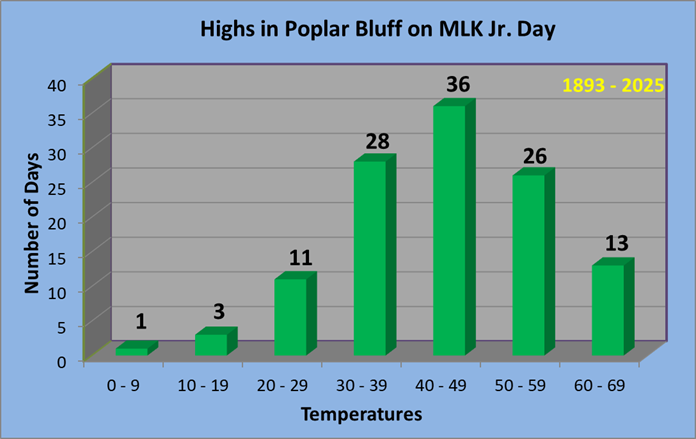
As seen by this graphic high temperatures are predominately in the 30s or 40s on MLK Jr Day, encompassing 55% of all years on record.
| Warmest Highs | Coldest Highs |
| 69 in 1901 | 3 in 1985 |
| 64 in 2012 | 10 in 1977 |
| 64 in 1928 | 13 in 2024 |
| 64 in 1919 | 15 in 1918 |
| 64 in 1895 | 21 in 2025* |
| Normal High: | 44 |
*Denotes a tie in previous year(s)
Poplar Bluff has seen highs in the 60s 13 times, most recently in 2017, when we topped out at 63 degrees. There have also been 4 years where the high temperature failed to reach 20 degrees. This happened most recently back in 2024 when the high was a frigid 13 degrees!
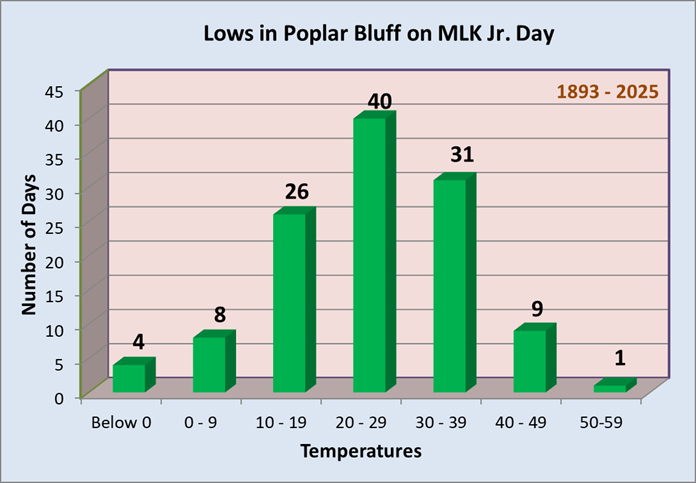
Low temperatures typically fall in the 20s, 30s or 40s, accounting for 83% of all years on record. There are always exceptions to the norm of course: there have been 4 years where the low dropped below zero, including in 1985 and 1977 when temperatures bottomed out at 11 degrees below zero. There has also been 1 year with lows remaining in the 50s, way back in 1894.
| Warmest Lows | Coldest Lows |
| 52 in 1894 | -11 in 1985 |
| 47 in 1900 | -11 in 1977 |
| 46 in 2023 | -9 in 1918 |
| 46 in 1933 | -3 in 2024 |
| 44 in 2012 | 1 in 1979 |
| Normal Low: | 27 |
*Denotes a tie in previous year(s)
Measurable precipitation has fallen 31% of the time, with over an inch of precipitation falling only once, back in 1962.
| Wettest |
| 1.82 in 1962 |
| 0.80 in 1935 |
| 0.73 in 1951 |
| 0.63 in 1949 |
| 0.60 in 1994 |
Here is a look at the observed weather for the past 15 years:
| Recent MLK Jr. Day Weather | |||
| Year | High | Low | Precip |
| 2011 | 45 | 24 | 0.06 |
| 2012 | 64 | 44 | 0 |
| 2013 | 41 | 27 | 0 |
| 2014 | 58 | 31 | 0 |
| 2015 | 63 | 33 | 0 |
| 2016 | 25 | 8 | 0 |
| 2017 | 63 | 41 | 0.12 |
| 2018 | 31 | 15 | 0.12 |
| 2019 | 30 | 20 | 0 |
| 2020 | 26 | 19 | T |
| 2021 | 50 | 28 | 0 |
| 2022 | 47 | 29 | 0 |
| 2023 | 59 | 46 | 0.08 |
| 2024 | 13 | -3 | 0.01 |
| 2025 | 21 | 7 | 0 |